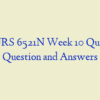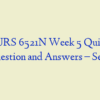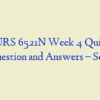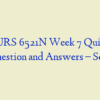Description
NURS 6521N Midterm Exam with Answers
- A 77-year-old man’s chronic heart failure is being treated with a regimen of quinapril (Accupril) and furosemide (Lasix). Which of the following assessment findings would suggest that the loop diuretic is contributing to a therapeutic effect?
- A Nurse Practitioner is caring for a patient who is taking digoxin and a loop diuretic. Which of the following would be most important for the Nurse Practitioner to monitor?
- An expected outcome for a patient who has just taken sublingual nitroglycerin should be
- A patient taking Metformin (Glucophage) is scheduled for a cardiac cath. The patient asks why he can’t take his metformin the day of the test. What is the most appropriate reply?
- The parents of a 7-year-old boy who has just been diagnosed with allergic asthma are being taught about their son’s medication regimen by the nurse. The nurse is currently teaching the parent’s about the appropriate use of a “rescue drug” for acute exacerbations of their son’s asthma. What drug should the nurse suggests the parents to use in these situations?
- A patient has recently been prescribed a drug that treats his hypertension by blocking the sympathetic receptors in his sympathetic nervous system. This action is characteristic of
- A female patient, age 36, is prescribed inhaled corticosteroid (ICS) for daily use. Which of the following adverse effects should the nurse closely monitor for in this patient?
- A 62-year-old man is admitted to the hospital with a diagnosis of chest pain. He has an order for 0.3 mg of sublingual nitroglycerin prn for chest pain. Which of the following actions should the nurse do first when he complains of chest pain?
- Mr. Lacuna is an 83-year-old resident of a long-term care facility who has a diagnosis of moderate Alzheimer disease. Mr. Lacuna’s physician recently prescribed oral rivastigmine, but he was unable to tolerate the drug due to its gastrointestinal effects. As a result, he has been ordered the transdermal patch form of the medication. When administering this form of rivastigmine, the nurse should
- It is determined that a patient, who is in a hepatic coma, needs a laxative. Lactulose is prescribed. Which of the following should the nurse monitor to assess the efficacy of the lactulose therapy?
- A high school student was diagnosed with asthma when he was in elementary school and has become accustomed to carrying and using his “puffers”. In recent months, he has become more involved in sports and has developed a habit of administering albuterol up to 10 times daily. The nurse should teach the student that overuse of albuterol can lead to
- Which statement is FALSE regarding the treatment of hyperthyroidism?
- A Nurse Practitioner who provides care in a busy clinic is aware of the high incidence and prevalence of hyperlipidemia and the consequent need for antihyperlipidemics in many patients. Treatment of high cholesterol using statins would be contraindicated in which of the following patients?
- A patient with a recent diagnosis of acute renal failure has a long-standing seizure disorder which has been successfully controlled for several years with antiseizure medications. The nurse should recognize that the patient’s compromised renal function will likely
- A Nurse Practitioner is caring for a patient who has been diagnosed with hypothyroidism. Levothyroxine (Synthroid) has been prescribed. Before the drug therapy is started, the nurse will assess for which of the following?
- Mr. Nguyen, age 71, will soon be discharged home from the hospital after a successful coronary artery bypass graft (CABG). During patient education about his drug regimen, Mr. Nguyen’s nurse should prioritize teach about
- A male patient is to begin glyburide (Diabeta) for type 2 diabetes. Before the drug therapy begins, a priority action by the nurse will be to assess the patient’s
- A 39-year-old African-American male is 25 pounds overweight and has been diagnosed with hypertension after three consecutive above-normal blood pressure readings. The most likely initial drug therapy for this patient will be
- The Nurse Practitioner is treating a patient that takes frequent doses of antacids for his heartburn and is also taking an enteric coded aspirin. What instructions should be provided to the patient?
- A patient has been prescribed lovastatin for a high cholesterol level. The nurse’s teaching plan will include a basic explanation of how the drug produces its therapeutic effect. The nurse will explain that lovastatin lowers cholesterol levels because it
- A 46-year-old white American has been prescribed a drug that binds to acid glycoproteins. The nurse understands that white Americans usually receive
- The APRN is caring for a patient taking a calcium channel blockers for hypertension. The APRN should monitor the patient for what common side effects of this medication?
- A 79-year-old woman who takes several medications for a variety of chronic health problems has been prescribed an oral antiplatelet aggregator that is to be taken once daily. The nurse has encouraged the woman to take the pill at the same time of day that she takes some of her other medications. What is the most likely rationale for the nurse’s advice?
- An older adult who lives in a long-term care facility has recently begun taking losartan (Cozaar) for the treatment of hypertension. The nurse who provides care for this resident should recognize that this change in the resident’s medication regimen make create a risk for
- A patient with a long history of alcohol abuse has been admitted to an acute medical unit with signs and symptoms of hepatic encephalopathy. His current medication orders include QID doses of oral lactulose. What desired outcomes should the nurse associate with this drug order?
- An elderly postsurgical patient has developed postoperative pneumonia in the days following abdominal surgery and is being treated with a number of medications. Which of the following medications that the nurse will administer has the slowest absorption?
- The APRN’s ability to prescribe controlled substances is regulated by:
- A patient is bothered with nighttime episodes of bronchoconstriction related to asthma. Which of the following medications can be administered to decrease the nighttime episodes and prevent asthma attacks?
- A Nurse Practitioner is providing care for a 71-year-old woman who was sponsored to emigrate from Mexico to the United States 6 months ago. Earlier this week, the woman slipped while getting off a bus and fractured her hip. How should the woman’s nurse best exemplify cultural competence in the care of this patient?
- A Nurse Practitioner is overseeing the care of a young man whose ulcerative colitis is being treated with oral prednisone. Which of the following actions should the Nurse Practitioner take in order to minimize the potential for adverse drug effects and risks associated with prednisone treatment?
- A patient receives 25 units of NPH insulin at 7.AM. At what time of day should the nurse advise the patient to be most alert for a potential hypoglycemic reaction?
- A Nurse Practitioner who provides care in a long-term care facility is documenting a new resident’s medication regimen on the resident’s intake admission. The Nurse Practitioner is documenting the generic, rather than proprietary, names of the resident’s current drugs because
- Mr. Penny, age 67, was diagnosed with chronic angina several months ago and has been unable to experience adequate relief of his symptoms. As a result, his physician has prescribed ranolazine (Ranexa). Which of the following statements is true regarding the use of ranolazine for the treatment of this patient’s angina?
- The APRN is seeing Mrs. Smith, age 77, who is here for follow up of hypertension, dyslipidemia, and depression. What should you consider during her follow-up?
- A normal maintenance dose for digoxin is 0.125 to 0.5 mg/day. In which of the following patients would the nurse most likely administer a lower-than-normal maintenance dose of digoxin?
- A mother brings her 4-year-old child, who is vomiting and has a temperature of 103°F into the emergency department (ED). The ED physician orders acetaminophen (Tylenol) for the fever. The best form of Tylenol to give the child, considering her presentation, would be
- A 70-year-old woman has experienced peripheral edema and decreasing stamina in recent months and has sought care from her primary care provider. The patient’s subsequent diagnostic workup has resulted in a diagnosis of chronic heart failure. The woman has been prescribed digoxin and the nurse has begun patient education. What should the nurse teach the patient about her new medication?
- A 79-year-old woman with a medical history that includes osteoporosis has recently moved to a long-term care facility. Medication reconciliation indicates that the woman has been taking calcitonin, salmon for several years. The nurse should recognize that the most likely route for the administration of this drug is
- A patient with type 1 diabetes has been admitted to the hospital for orthopedic surgery and the care team anticipates some disruptions to the patient’s blood glucose levels in the days following surgery. Which of the following insulin regimens is most likely to achieve adequate glycemic control?
- A woman with numerous chronic health problems has been diagnosed with a benign gastric ulcer has begun treatment with ranitidine (Zantac). Which of the following teaching points should the nurse provide to this patient?
- A woman has a long history of seasonal allergies that are typically accompanied by rhinorrhea, red eyes, and frequent sneezing. Sneezes are a result of
- Which of the following is TRUE about long acting beta agonist use in asthma patients?
- A Nurse Practitioner is caring for a male patient who has a diagnosis of coronary artery disease (CAD). His drug therapy includes lovastatin. Because the patient has a history of severe renal disease, the nurse will assess for which of the following?
- To minimize the risk of adverse effects of glucagon when given to an unconscious diabetic patient, as the patient regains consciousness, the nurse should
- A 56-year-old female patient has been admitted to the hospital with chronic muscle spasms and has been prescribed a new medication to treat the spasms. She has a poorly documented allergy to eggs, synthetic clothes, and perfumes. What is the priority action of the nurse to ensure that prescribed medication does not experience an allergic reaction?
- Federal legislation dictates a lengthy and rigorous process of testing for new drugs. What is the primary purpose of this testing process?
- A female patient with a diagnosis of type 1 diabetes mellitus has been experiencing increasing neuropathic pain in recent months, a symptom that has not responded appreciably to conventional analgesics. The patient’s care provider has begun treatment with gabapentin (Neurontin). How is the addition of this drug likely to influence the management of the patient’s existing drug regimen?
- Mr. Tan is a 69-year-old man who prides himself in maintaining an active lifestyle and a healthy diet that includes adequate fluid intake. However, Mr. Tan states that he has experienced occasional constipation in recent months. What remedy should be the nurse’s first suggestion?
- A Nurse Practitioner is discussing with a patient the efficacy of a drug that his physician has suggested, and he begin taking. Efficacy of a drug means which of the following?
- A 24-year-old factory worker has been prescribed guaifenesin for the first time. Which of the following will be a priority assessment by the nurse before the patient’s first dose?
- A child with sinusitis has been on antibiotics for seven days and his symptoms are not improving. All of the following are options to prescribe for the patient now EXCEPT:
- A clinic Nurse Practitioner has been assigned a 49-year-old female patient who has a history of diabetes. A recent diagnosis of hypertension has been made, and the patient has been prescribed a thiazide diuretic and labetalol. The patient will be scheduled to return to the clinic once a month for the next 6 months. A priority action by the Nurse Practitioner will be to
- A Nurse Practitioner receives an order to administer a critically ill patient two drugs immediately (stat). The Nurse Practitioner begins the process by54. Decongestants are recommended to use in which of the following patients?
- Following an endoscopy, a 66-year-old man has been diagnosed with a duodenal ulcer resulting from Helicobacter pylori infection. Which of the following medications will likely be used in an attempt to eradicate the patient’s H. pylori infection? (Select all that apply.)
- In order to promote therapeutic drug effects, the Nurse Practitioner should always encourage patients to
- The APRN is prescribing a medication that is known to induce hepatic enzymes. What effect should you anticipate?
- Which of the following would be an expected outcome in a patient who has been given atropine during a medical emergency? nurs 6521n midterm exam
- A 62 year old male who had a myocardial infarction one year ago is being seen for hypertension. Which medication has the best evidence in mortality reduction?
- Following an assessment by her primary care provider, a 70-year-old resident of an assisted living facility has begun taking daily oral doses of levothyroxine. Which of the following assessment findings should prompt the nurse to withhold a scheduled dose of levothyroxine?
- A patient is being treated for respiratory infection. He is a recovering alcoholic and has impaired liver function. The nurse will instruct the patient to be especially cautious when taking
- Advanced practice nurse prescribing of scheduled medications is affected most by:
- A Nurse Practitioner is caring for a female patient who has developed atelectasis because of thick mucus secretions. The Nurse Practitioner is monitoring IV administration of acetylcysteine (Mucomyst) and notices that the patient’s face is flushed. The appropriate nursing action would be to
- A 60-year-old man has scheduled a follow-up appointment with his primary care provider stating that the omeprazole (Prilosec) which he was recently prescribed is ineffective. The patient states, “I take it as soon as I feel heartburn coming on, but it doesn’t seem to help at all.” How should the nurse best respond to this patient’s statement? nurs 6521n midterm exam
- A Nurse Practitioner explains to a patient that nitroglycerin patches should be applied in the morning and removed in the evening. This medication schedule reduces the potential for
- A 48-year-old woman who works as an office manager is prescribed metoclopramide (Reglan) for diabetic gastroparesis. The nurse will be sure to assess the patient for nurs 6521n midterm exam
- A clinic Nurse Practitioner is planning care for a 68-year-old man who has been on omeprazole (Prilosec) therapy for heartburn for some time. Regarding the patient’s safety, which of the following would be a priority nursing action?
- The Nurse Practitioner is conducting a medication reconciliation of a new resident of a long-term care facility. The Nurse Practitioner notes that the resident takes allopurinol on a daily basis for the treatment of gout. What is the primary purpose of this drug?
- An unconscious patient has been brought to the hospital, and the Nurse Practitioner has prescribed a life-saving drug to be administered parenterally. Which of the following methods would be the most appropriate for the nurse to use when administering the medication?
- A Native American man who lives a traditional lifestyle is scheduled to have heart surgery. The tribal chief has requested that the tribe’s medicine man perform a ritual before the patient goes to surgery. The nurse’s response to this request should be
- A Nurse Practitioner is providing patient education to a 35-year-old man who has been prescribed clonidine (Catapres) as part of step 2 antihypertensive therapy. The Nurse Practitioner should anticipate that the drug will be administered
- A diabetic patient being treated for obesity tells the Nurse Practitioner that he is having adverse effects from his drug therapy. The patient has been taking dextroamphetamine for 2 weeks as adjunct therapy. Which of the following adverse effects would need the Nurse Practitioner’s immediate attention? nurs 6521n midterm exam
- The lower respiratory system utilizes a number of different mechanisms that confer protection and maintain homeostasis. Which of the following physiological processes protects the lower respiratory system?
- A 22-year-old male college senior has lived with a diagnosis of Crohn’s disease for several years and has undergone several courses of treatment with limited benefit. Which of the following targeted therapies has the potential to alleviate the symptoms of Crohn’s disease?
- A Nurse Practitioner has been following a male patient who is taking hydralazine, clonidine, and a diuretic for hypertension. After 2 weeks of medication therapy, the patient begins to complain of numbness and tingling in his hands and feet. The Nurse Practitioner suspects that these signs or symptoms are
- A patient in need of myocardial infarction prophylaxis has been prescribed sulfinpyrazone for gout. Which of the following will the nurse monitor the patient most closely for?
- Topical inhaled alpha adrenergic blocking agents or nasal vasoconstricting decongestants should not be used chronically (>5 days) because they can cause nurs 6521n midterm exam
- A Nurse Practitioner is caring for a 70-year-old patient who is taking desmopressin (DDAVP). The patient has a history of cardiovascular disease. The nurse will prioritize the assessment of which of the following?
- A male patient is to begin treatment for pneumonia with an albuterol (Ventolin) inhaler. The nurse will advise the patient that he will most likely experience which of the following common adverse effects of the drug?
- A patient has a history of tonic-clonic seizures that have been successfully treated with phenytoin (Dilantin) for several years. Phenytoin achieves a therapeutic effect by nurs 6521n midterm exam
- Mesalamine (Asacol) is prescribed for a 22-year-old woman with Crohn disease. The nurse will discuss with the patient the possibility for which of the following adverse effects related to the new drug therapy?
- A patient who takes aluminum hydroxide with magnesium hydroxide (Mylanta) frequently for upset stomach, heartburn, and sour stomach is seen regularly in the clinic. The nurse should assess which of the following?
- A Nurse Practitioner is a member of a research team that is exploring unique differences in responses to drugs that each individual possesses, based on genetic make-up. This area of study is called
- The APRN should educate a diabetic patient that beta blockers may mask the signs and symptoms of85. A patient has been prescribed a drug that can be self-administered at home. Which of the following would be the most important information for the nurse to relate to the patient concerning self-administration of a drug?
- A patient has been admitted to the ICU because of multiple traumas due to a motor vehicle accident. The physician has ordered propofol (Diprivan) to be used for maintenance of sedation. Before administration of propofol, a priority assessment by the nurse would be to check for a history of
- A patient with unstable angina pectoris who is NOT controlled with a nitrate would likely benefit most from the addition of: nurs 6521n midterm exam
- A Nurse Practitioner who provides care for older adults is aware of the high incidence of drug interactions in this population. When educating a group of seniors about the prevention of drug interactions, the Nurse Practitioner should encourage them to
- The Nurse Practitioner’s assessment of a community-dwelling adult suggests that the client may have drug allergies that have not been previously documented. What statement by the client would confirm this?
- In which of the following patients would a Nurse Practitioner expect to experience alterations in drug metabolism?
- A 22 year old patient is transitioning from oral agents to insulin. He will be taking 20 units of lantus at bedtime and regular insulin before meals. What instructions should the NP provide about the timing and dose of regular insulin?
- A patient has been prescribed a histamine-2 (H2) receptor antagonist for the treatment of GERD. Why are H2RAs more effective than H1 receptor antagonists in the treatment of diseases of the upper GI tract?
- A Nurse Practitioner is instructing a patient who was recently diagnosed with multiple sclerosis about dantrolene (Dantrium). The patient is a 38-year-old-male and the foreman for a construction company. In order to minimize one important adverse effect of the drug, the nurse will give the patient which of the following instructions? nurs 6521n midterm exam
- A patient with diabetes has had a cough for 1 week and has been prescribed a cough syrup (an expectorant). What special instructions should the nurse include in the patient teaching for this situation?
- A 77-year-old patient has a long-standing history of hypertension, a health problem that is being treated with metoprolol and a thiazide diuretic. Before administering the 8 AM dose of these medications, what assessments should the nurse perform and document? (Select all that apply.)
- A patient has been prescribed zolpidem (Ambien) for short-term treatment of insomnia. Which of the following will the nurse include in a teaching plan for this patient? (Select all that apply.)
- A Nurse Practitioner is caring for a 78-year-old patient with renal insufficiency and chronic heart failure who is receiving rapid infusions of high-dose furosemide. It will be a priority for the Nurse Practitioner to monitor for
- A resident of a long-term care facility receives 12.5 mg metoprolol (Lopressor) at 8 AM and 8 PM daily. Before administering this drug, the nurse should perform and document what assessments?
- During a clinic visit, a patient complains of having frequent muscle cramps in her legs. The nurse’s assessment reveals that the patient has been taking over-the-counter laxatives for the past 7 years. The nurse informed the patient that prolonged use of laxatives nurs 6521n midterm exam
- A 70-year-old man with diabetes mellitus is taking metoprolol (Lopressor) to manage his hypertension. The nurse would be sure to instruct the patient to










